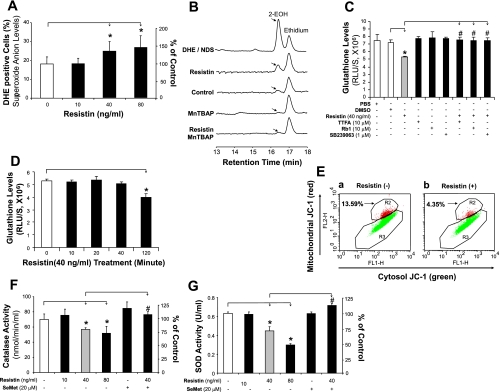Fig. 3.
Effect of resistin on oxidative stress in HCAECs. A: reactive oxygen species (ROS) production [dihydroethidium (DHE) staining and flow cytometry analysis]. HCAECs were treated with 40 or 80 ng/ml of resistin for 24 h. *P < 0.05, n = 3. B: superoxide anion (O2−) levels (DHE staining and HPLC analysis). HCAECs were treated with resistin (40 ng/ml) for 3 h, and then DHE (25 μM) was added to the cells for 30 min. Cellular levels of 2-hydroxyethidium (2-EOH) and ethidium were determined by HPLC analysis. Positive control of 2-EOH was prepared by using nitrosodisulfonate radical dianion (NDS) with DHE in the aqueous phosphate buffer, pH 7.4, containing diethylene triamine pentaacetic acid (DTPA). Specific O2− scavenger manganese [III] tetrakis(4-benzoic acid)porphyrin [MnTBAP, superoxide dismutase (SOD) mimetic] was used. C: ROS production (glutathione assay). HCAECs were treated with resistin and/or other molecules for 24 h. RLU, relative light units; TTFA, thenoyltrifluoroacetone. *P < 0.05, n = 3 [compared with dimethyl sulfoxide (DMSO) controls]. #P < 0.05, n = 3 (compared with resistin treatment alone). D: time course of ROS production (glutathione assay). HCAECs were treated with resistin (40 μg/ml) for different time points. *P < 0.05, n = 3 [compared with dimethyl sulfoxide (DMSO) controls]. #P < 0.05, n = 3 (compared with resistin treatment alone). E: mitochondrial membrane potential (JC-1 staining and flow cytometry). F: catalase activity assay. HCAECs were treated with resistin (40 or 80 ng/ml) and/or selenomethionine (SeMet, 20 μM) for 24 h. *P < 0.05, n = 3 (compared with DMSO controls). #P < 0.05, n = 3 (compared with resistin treatment alone). G: SOD activity assay. HCAECs were treated with resistin (40 or 80 ng/ml) and/or SeMet (20 μM) for 24 h. *P < 0.05, n = 3 (compared with DMSO controls). #P < 0.05, n = 3 (compared with resistin treatment alone).

